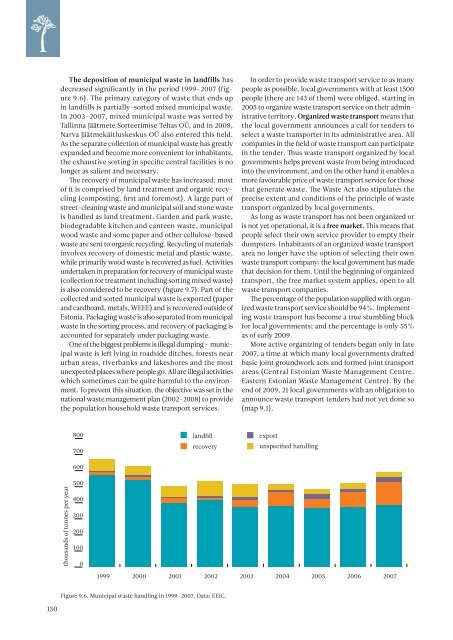ESTONIAN ENVIRONMENTAL REVIEW 2009
ESTONIAN ENVIRONMENTAL REVIEW 2009
ESTONIAN ENVIRONMENTAL REVIEW 2009
Create successful ePaper yourself
Turn your PDF publications into a flip-book with our unique Google optimized e-Paper software.
The deposition of municipal waste in landfills has<br />
decreased significantly in the period 1999–2007 (figure<br />
9.6). The primary category of waste that ends up<br />
in landfills is partially-sorted mixed municipal waste.<br />
In 2003–2007, mixed municipal waste was sorted by<br />
Tallinna Jäätmete Sorteerimise Tehas OÜ, and in 2008,<br />
Narva Jäätmekäitluskeskus OÜ also entered this field.<br />
As the separate collection of municipal waste has greatly<br />
expanded and become more convenient for inhabitants,<br />
the exhaustive sorting in specific central facilities is no<br />
longer as salient and necessary.<br />
The recovery of municipal waste has increased; most<br />
of it is comprised by land treatment and organic recycling<br />
(composting, first and foremost). A large part of<br />
street-cleaning waste and municipal soil and stone waste<br />
is handled as land treatment. Garden and park waste,<br />
biodegradable kitchen and canteen waste, municipal<br />
wood waste and some paper and other cellulose-based<br />
waste are sent to organic recycling. Recycling of materials<br />
involves recovery of domestic metal and plastic waste,<br />
while primarily wood waste is recovered as fuel. Activities<br />
undertaken in preparation for recovery of municipal waste<br />
(collection for treatment including sorting mixed waste)<br />
is also considered to be recovery (figure 9.7). Part of the<br />
collected and sorted municipal waste is exported (paper<br />
and cardboard, metals, WEEE) and is recovered outside of<br />
Estonia. Packaging waste is also separated from municipal<br />
waste in the sorting process, and recovery of packaging is<br />
accounted for separately under packaging waste.<br />
One of the biggest problems is illegal dumping – municipal<br />
waste is left lying in roadside ditches, forests near<br />
urban areas, riverbanks and lakeshores and the most<br />
unexpected places where people go. All are illegal activities<br />
which sometimes can be quite harmful to the environment.<br />
To prevent this situation, the objective was set in the<br />
national waste management plan (2002–2008) to provide<br />
the population household waste transport services.<br />
In order to provide waste transport service to as many<br />
people as possible, local governments with at least 1500<br />
people (there are 143 of them) were obliged, starting in<br />
2005 to organize waste transport service on their administrative<br />
territory. Organized waste transport means that<br />
the local government announces a call for tenders to<br />
select a waste transporter in its administrative area. All<br />
companies in the field of waste transport can participate<br />
in the tender. Thus waste transport organized by local<br />
governments helps prevent waste from being introduced<br />
into the environment, and on the other hand it enables a<br />
more favourable price of waste transport service for those<br />
that generate waste. The Waste Act also stipulates the<br />
precise extent and conditions of the principle of waste<br />
transport organized by local governments.<br />
As long as waste transport has not been organized or<br />
is not yet operational, it is a free market. This means that<br />
people select their own service provider to empty their<br />
dumpsters. Inhabitants of an organized waste transport<br />
area no longer have the option of selecting their own<br />
waste transport company: the local government has made<br />
that decision for them. Until the beginning of organized<br />
transport, the free market system applies, open to all<br />
waste transport companies.<br />
The percentage of the population supplied with organized<br />
waste transport service should be 94%. Implementing<br />
waste transport has become a true stumbling block<br />
for local governments; and the percentage is only 55%<br />
as of early <strong>2009</strong>.<br />
More active organizing of tenders began only in late<br />
2007, a time at which many local governments drafted<br />
basic joint groundwork acts and formed joint transport<br />
areas (Central Estonian Waste Management Centre,<br />
Eastern Estonian Waste Management Centre). By the<br />
end of <strong>2009</strong>, 21 local governments with an obligation to<br />
announce waste transport tenders had not yet done so<br />
(map 9.1).<br />
800<br />
700<br />
600<br />
landfill<br />
recovery<br />
export<br />
unspecified handling<br />
thousands of tonnes per year<br />
500<br />
400<br />
300<br />
200<br />
100<br />
0<br />
1999 2000 2001 2002 2003 2004 2005 2006 2007<br />
Figure 9.6. Municipal waste handling in 1999–2007. Data: EEIC.<br />
150

















